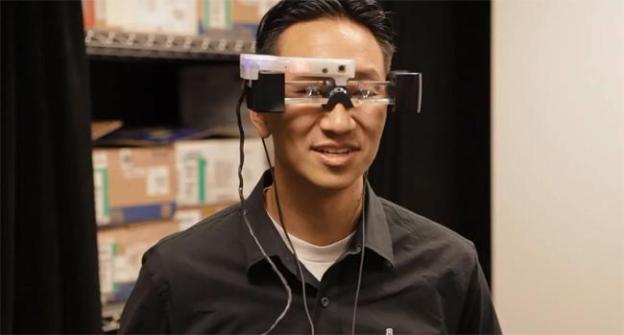
All the cool kids at Google I/O may be walking around with Google Glass, but they can only see the interface out of one eye and need to use their voice or swipe their finger against the side of the eyewear to navigate the device. With the APX Labs enhanced smart glasses from Epson, called the Moverio BT-100, you can navigate a virtual wall of YouTube videos with just a tilt of your head.
These Epson smart glasses have actually been on the market for over a year and are the result of over 15 years of research and development. While Google Glass is more geared for consumers, the Moverio BT-100 has its eyes set on developers and commercial uses for hands-free computing.
As you can see in the photo, the $700 Moverio smart glasses feature a pair of transparent lenses so you can see 3D augmented reality content projected on top of the real world. Eric Mizufuka, product manager of new markets for Epson, assured us that looking through these glasses is like looking at a “floating” 80-inch display. These glasses also have on-board Wi-Fi connectivity and are wired to an Android-based mini-touchpad where you can side-load content like Angry Birds via its microSD card slot.
But without a front-facing camera or other motion sensors, the Moverio glasses have limited functionality. That’s why APX Labs updated the BT-100 with a 5-megapixel camera, a microphone, and motion sensors like a gyroscope, an accelerometer, and a magnetometer. Currently, these additions to the Epson glasses are housed in a white box above the lenses, but both companies would like to work those technologies into the frames so they will look more slick over time.
To show off what these suped up Moverio glasses can do, APX Labs also created a YouTube app that takes advantage of its Northstar user interface to navigate a wall of videos using just your head movements. To see all the videos that are available on the app, you simply have to move your head left and right to bring those clips within view, according to APX Labs’ Director of Research and Development Jay Kim. When you want to watch a particular video, simply look up or down at the video until it gets highlighted, and it will start playing. To fast-forward or rewind the clip, just turn your head to the right or left, respectively.
These APX Labs enhanced Moverio smart glasses from Epson makes hands-free navigation extremely intuitive, and we hope it will be able to bring their expertise to the consumer realm soon.
[Image via the MoverioChannel on YouTube]



